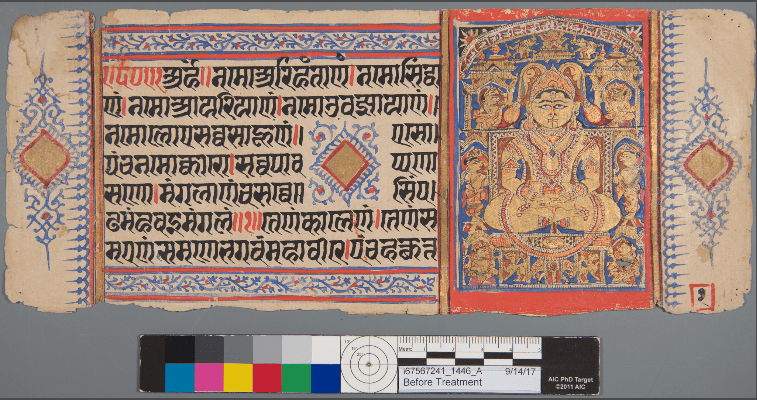 Written by Katrina Marshall, Digital Services Supervisor, Genealogy & Local History Department, Downtown Main Library and Ashleigh Schieszer, Conservation Lab Manager, Conservation Services, Preservation Lab
Written by Katrina Marshall, Digital Services Supervisor, Genealogy & Local History Department, Downtown Main Library and Ashleigh Schieszer, Conservation Lab Manager, Conservation Services, Preservation Lab
Nearly 9 million items are in the Cincinnati & Hamilton County Public Library’s collection, making it second in the nation for public library holdings. The collection contains today’s popular novels, music, and movies, but as one of the oldest public library collections, it also includes materials rarely found elsewhere. From the rescued history of the Inland Rivers Special Collection, opens a new window to hundreds of WWI and WWII war bond posters, opens a new window, the Library ensures these treasures are preserved for future generations to discover.
The ongoing care of these collections is tasked to a unique partnership between the Library's Genealogy & Local History Department, opens a new window and the Preservation Lab, opens a new window, a collaborative department shared between CHPL and the University of Cincinnati. During Preservation Week (April 24 –30), we’re sharing a peek into the preservation process of a unique religious text and a chance for you to meet with our preservation team in person!
Tricky Terminology
Digitization and preservation are two terms often used when talking about the care of rare materials, and both are key processes used in the Library’s collection.
Digitization is the process of converting print objects, photographs, 3D objects, and film into computer-readable formats. Digitization is important for preserving an object and allows access to rare and fragile materials while preserving the original condition of the object. Library staff digitizes tens of thousands of items which are then available on CHPL’s Digital Library, including the fascinating local history highlighted in our monthly Throwback Thursday blog posts, opens a new window.
Preservation encompasses the work to prolong the existence of cultural property. Conservation treatments are performed by trained professionals to minimize chemical and physical deterioration to prevent loss of informational content for a variety of uses. These include exhibition, research, loan, and more, including digitization!
Selecting Items for Preservation and Digitization
Librarians and our community are essential in the selection process of determining materials that are a priority for conservation and/or preservation. With such a large collection of material in many formats, several factors are considered, including the item’s value (both monetary and cultural), connection to Cincinnati history, uniqueness, age, and current condition.
In 2012, a Kalpasūtra manuscript, opens a new window, an example of a Jain religious text, was selected for digitization. While the manuscript is undated, it could have been created as early as the 16th century. Given this item’s potential age and uniqueness, it was considered a suitable candidate for digitization. Before the manuscript was scanned, its condition was evaluated and a digitization plan was developed to ensure the safety of the manuscript during scanning.
Treatment
To preserve the object for years to come, the Preservation Lab first evaluated the Kalpasūtra manuscript’s condition, taking into consideration the illuminated pages that showed early signs of pigment corrosion. When certain pigments contain copper, such as verdigris or gold, the copper can corrode in the presence of moisture. This corrosion can be damaging to paper, leading to cracking and darkening of the page. This can result in fragmentation and sometimes paper loss. Therefore, research was conducted on the history and best practices for storage.
Prior to treatment, the object’s condition was documented photographically (as seen above) and with written documentation called an examination report. To treat, a preventive conservation treatment was provided to encapsulate and protect the most fragile pages during handling and long-term storage. This improved storage helps buffer the illuminated manuscript from humidity and moisture in the environment, mitigating further pigment corrosion to the paper while making it accessible for handling.
After scanning, image editing, and metadata creation, the Kalpasūtra manuscript was added to CHPL’s Digital Library. Read more about the conservation research of this project on the Preservation Lab blog, opens a new window.
Get a Sneak Peek Into the Preservation Lab
As part of our Preservation Week, opens a new window celebration, you can chat with Preservation Lab staff in person and preservation materials to touch and experience on April 29 at the Clifton Branch Library!
Sneak Peek Into The Preservation Lab, opens a new window is an open house program, presented by the Library’s Preservation Lab. Ashleigh Schieszer, CHPL Conservation Lab Manager, and Holly Prochaska, UC Libraries Preservation Librarian, will be available to answer questions from the community.
What is your favorite item in our rare print and digital collections, opens a new window? Let us know in the comments below!




Add a comment to: Preserving a 16th Century Text and Other Treasures for Future Generations